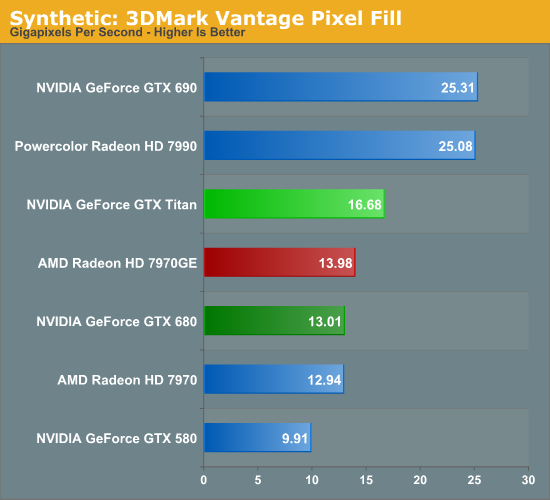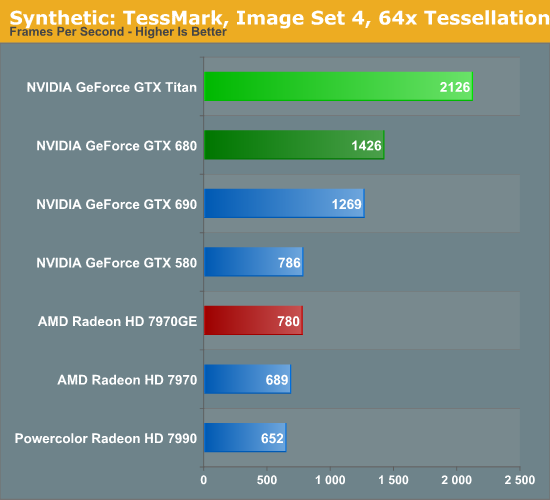NVIDIA’s GeForce GTX Titan Review, Part 2: Titan's Performance Unveiled
by Ryan Smith & Rahul Garg on February 21, 2013 9:00 AM ESTSynthetics
As always we’ll also take a quick look at synthetic performance to get a better look at Titan’s underpinnings. These tests are mostly for comparing cards from within a manufacturer, as opposed to directly comparing AMD and NVIDIA cards. We’ll start with 3DMark Vantage’s Pixel Fill test.

Pixel fill is a mix of a ROP test and a test to see if you have enough bandwidth to feed those ROPs. At the same time the smallest increase in theoretical performance for Titan over GTX 680 was in ROP performance, where a 50% increase in ROPs was met with a minor clockspeed reduction for a final increase in ROP performance of 25%.
The end result is that with gains of 28%, Titan’s lead over GTX 680 is just a hair more than its increase in theoretical ROP performance. Consequently at first glance it looks like Titan has enough memory and cache bandwidth to feed its 48 ROPs, which given where we’re at today with GDDR5 is good news as GDDR5 has very nearly run out of room.
Moving on, we have our 3DMark Vantage texture fillrate test, which does for texels and texture mapping units what the previous test does for ROPs.

Oddly enough, despite the fact that Titan’s texture performance improvements over GTX 680 were only on the range of 46%, here Titan is measured as having 62% more texturing performance. This may be how Titan is interplaying with its improved bandwidth, or it may be a case where some of the ancillary changes NVIDIA made to the texture paths for compute are somehow also beneficial to proper texturing performance.
Finally we’ll take a quick look at tessellation performance with TessMark.

Unsurprisingly, Titan is well ahead of anything else NVIDIA produces. At 49% faster it’s just a bit over the 46% theoretical performance improvement we would expect from the increased number of Polymorph Engines the extra 6 SMXes bring. Interestingly, as fast as GTX 580’s tessellation performance was, these results would indicate that Titan offers more than a generational jump in tessellation performance, nearly tripling GTX 580’s tessellation performance. Though at this time it’s not at all clear just what such tessellation performance is good for, as we seem to be reaching increasingly ridiculous levels.










337 Comments
View All Comments
Veteranv2 - Friday, February 22, 2013 - link
Wow, you base your opinion on 1 game on a point that 1 review site has made without knowing that the FRAPS software measures correctly and that drivers are good with that game?Wow, that blows my mind. How dumb can be people be?
This is the same like saying, wow this 1 musquito didn't give me malaria, malaria doesn't exist....
I am not a fanboy, except for my wallet and honesty.
Anandtech makes a point which it does not prove. That is my point. Hence if you cannot prove a point, but still make it, that makes you subjective. So either prove it, or shut up about it and be objective.
CeriseCogburn - Saturday, February 23, 2013 - link
Yeah it's not one site, this into has been around for years.Just run fraps with your own games vs other frame count methods on both cards idiot.
Oh that's right, you have no experience.
Veteranv2 - Sunday, February 24, 2013 - link
Wow, you are the saddest person I have ever seen on the internet. You seem like you could use a hug or something.Or professional help.
CeriseCogburn - Tuesday, February 26, 2013 - link
Another internet parrot with the usual, repeated a thousand times whenever they have no rebuttal.You fit right in with the rest of the fools.
carlos l - Thursday, February 21, 2013 - link
Titan's most interesting feature is DP performance. The previous gtx 6xx cards have only 1/24 DP, much less than the gtx 5xx. Titan's announced 1/3 DP performance is, in theory, an amazing improvement for gpgpu tasks. It woul be nice if you could ad a benchmark on that feature. I suggest something like GeneferCUDA, an app from Primegrid (a Boinc project) designed for cuda capable cards that uses DP intensively.codedivine - Thursday, February 21, 2013 - link
Look at the DGEMM and FFT (double-precision) benchmarks. Those are both using fp64.chizow - Thursday, February 21, 2013 - link
While the DP performance is great for those that would use it, I think the vast majority of potential buyers would've preferred to see the same neutered DP performance if it meant a more reasonable, historic level of pricing in the $500-$650 range.As a previous owner of these flagship cards, I know I gave 0 fks about the DP performance of the card even though it was respectable relative to the Tesla parts (about half).
alpha754293 - Thursday, February 21, 2013 - link
Does it have the same PCI devID as the Tesla cards?I like how Rahul Garg covered the compute performance using HPC-level code.
Do you or does he know if MATLAB will work with this card?
Thanks.
codedivine - Thursday, February 21, 2013 - link
Rahul here. Not sure about the PCI ID. About MATLAB, while we did not test this, but I see no reason why it will not work with MATLAB.alpha754293 - Thursday, February 21, 2013 - link
Rahul:I loved your analysis. Very useful.
One question question though - nVidia was saying that the single precision peak theorectical floating point rate should be 4.5 TFLOPs. How come your SGEMM only shows 3.something TFLOPS? Is it tuning or optimizations?